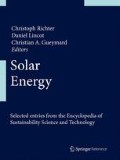Access this chapter
Tax calculation will be finalised at checkout
Purchases are for personal use only
Abbreviations
- Absorptivity or absorptance (α):
-
The fraction of the incoming radiation which is absorbed at a specified wavelength (absorptivity) or summed over a specified spectrum range (absorptance). Absorptivity and absorptance are dimensionless quantities.
- Collector area: Aperture, absorber, and gross area:
-
Net area (of a flat surface) through which the collector receives solar radiation. The gross collector area, the aperture area, or the absorber area can be used. Usually, the performance of the collector is referred to the aperture area. For nonflat areas, a projected area is used for the aperture area, but the full surface area is taken for absorber areas.
- Collector mean temperature (Tm):
-
Defined, in operating terms, as the average value of the inlet and outlet temperatures of the collector (fluid) medium:
$$ {\rm{T_m}} = \frac{{{T_{outlet}} + {T_{inlet}}}}{2}.$$ - Emissivity (ε):
-
Ratio of energy radiated by a particular material at a certain temperature to energy radiated by a blackbody at the same temperature. For a true blackbody, ε = 1, while any real object would have ε < 1.
- Emittance (M):
-
Quantitative ability of a material to release radiative heat per area (W/m2).
- Evacuated tube collector (ETC):
-
Solar collector with many parallel glass tubes each covering an individual long and slim absorber. The glass tubes maintain a vacuum insulation cavity around the absorber.
- Flat plate collector (FPC):
-
Solar collector with a large flat absorber. Optionally, a flat cover (covered flat plate collector) and conventional thermal insulation can be added to reduce thermal losses.
- Heat pipe:
-
Heat transfer construction enabling heat transfer through (closed) convective mass flow. Usually, a critical fluid-gas material is used where gas rises when a fluid is heated below and flows down again when cooled at the top (liquid), thus transferring some sensible but also large amounts of latent heat. Very high heat transfer rates can be sustained through a single, small channel.
- Incident angle modifier (IAM):
-
Dependence of the collector efficiency on the angle between the solar beam radiation incident on a surface and the normal to the collector surface. With increasing incidence angle, reflections of the cover usually increase and the performance of the covered collector drops.
- Operating temperature difference:
-
Difference between the collector mean temperature (Tm) and the ambient temperature (Ta). Usually, the collector performance curve is shown dependent on the operating temperature difference.
- (Solar) Irradiance (G):
-
Irradiated power density (in W/m2) of (solar) radiation. An example is the solar constant, that is, the solar irradiance measured just outside the earth’s atmosphere, which is roughly 1,361 W/m2.
- Spectral-selective coating:
-
Multilayer surface coating with high absorptivity in the wavelength range of solar radiation and low emissivity in the infrared thermal radiation range so that radiative thermal losses of the solar absorber are reduced.
- Solar fraction (Fsav):
-
Ratio of solar energy to total energy used by a heating system. Calculated from the auxiliary energy still needed when using solar energy, divided by the energy needed by a comparable reference system that does not use solar energy:
$$ {F_{sav}} = 1 - \frac{{{Q_{aux}}}}{{{Q_{ref}}}}. $$ - Solar spectrum AM 1.5:
-
Typical spectral distribution of the solar radiation intensity on the earth resulting from transmission through an air mass of 1.5 times (AM 1.5) the thickness of the atmosphere of the earth, which corresponds with incoming solar radiation at an (solar zenith) angle of roughly 45° (to the vertical axis).
Bibliography
Butti K, Perlin J (1980) A golden thread: 2500 years of solar architecture and technology. Cheshire Books, Van Nostrand Reinhold Company, New York/London
Weiss W, Mauthner F (2011) Solar heat worldwide. Solar heating & cooling program, IEA
European Solar Thermal Technology Platform (2008) Solar heating and cooling for a sustainable energy future in Europe. www.rhc-platform.org/cms/index.php?id=11. Accessed 10 Mar 2011
Duffie J, Beckmann W (2006) Solar engineering of thermal processes, 3rd edn. Wiley, Hoboken
BINE (1999) Informationsdienst Projektinfo 5/99: Selektive Absorberbeschichtungen in Solarkollektoren
IEA-SHC Task 39: Polymeric materials in solar thermal applications. www.iea-shc.org. Accessed 23 Mar 2011
Website of C.G.A. Compagnia Generale Alluminio S.p.A. http://www.cgaspa.it/eng/evaporators.htm. Accessed 5 Apr 2011
IEA-SHC Task 18: Solar materials R&D. www.iea-shc.org. Accessed 1 Apr 2011
IGDB, International Glazing Database, Lawrence Berkeley National Laboratory, http://windows.lbl.gov/materials/IGDB/. Accessed 15 Mar 2011
SPF, Solartechnik Prüfung Forschung, Rapperswil, Swiss. http://www.solarenergy.ch/Test_Reports-Glasses. Accessed 10 Jan 2011
Schüle K, Siems T, (2009) Vakuumröhren-Luftkollektor für hohe solare Deckungsgrade, Erneuerbare Energie 2009-01, AEE Intec, Austria
Author information
Authors and Affiliations
Corresponding author
Editor information
Editors and Affiliations
Rights and permissions
Copyright information
© 2013 Springer Science+Business Media New York
About this entry
Cite this entry
Fortuin, S., Stryi-Hipp, G. (2013). Solar Collectors , Non-concentrating . In: Richter, C., Lincot, D., Gueymard, C.A. (eds) Solar Energy. Springer, New York, NY. https://doi.org/10.1007/978-1-4614-5806-7_681
Download citation
DOI: https://doi.org/10.1007/978-1-4614-5806-7_681
Published:
Publisher Name: Springer, New York, NY
Print ISBN: 978-1-4614-5805-0
Online ISBN: 978-1-4614-5806-7
eBook Packages: EnergyReference Module Computer Science and Engineering

